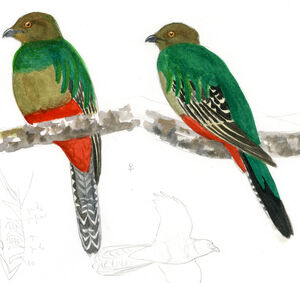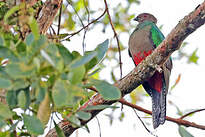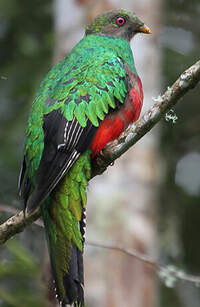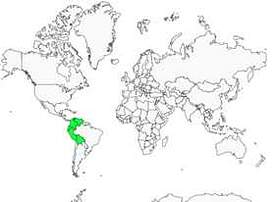Crested Quetzal
Pharomachrus antisianus - Quetzal antisien
Identification
The Creasted Quetzal, scientifically known as Pharomachrus antisianus, owes its name to French explorer Alcide Dessalines d'Orbigny (1802-1857) who discovered this extraordinary trogonidÄ" in 1837 in Bolivia. D'Orbigny was first and foremost a naturalist and explorer who traveled for 7 years through South America, studying the indigenous people and trying to categorize them into different families, one of which he named the antisian family, located in Peru and Andean Bolivia. This incredible explorer took 13 years to write his memoirs in which he classified 783 species of birds, including our Crested Quetzal, which has an exclusive Andean distribution area. Measuring 34 cm, it is sometimes considered conspecific with the Resplendent Quetzal; its beak is bicolored, orange at the base with a yellow tip, the male has a red iris. The cap, forehead and mustache are green with golden reflections, and are made up of longer feathers that give our quetzal a characteristic crest and disheveled look. The upper part of the chest is green, the belly and the lower part of the chest is very bright red, almost electric, the mantle and back are emerald green with turquoise blue reflections. The vertical green coverlets extend down to the abdomen, the remiges are black, the long primary remiges bend on the rump. The three pairs of lower rectrices are white, while the upper rectrices are black and slightly protrude. When viewed from the front, the bird has a black horizontal stripe across its tail. The emerald green upper tail coverts cover almost all of the rectrices; like the Brilliant or Golden quetzal, they extend to form a tricolor white, black and green at the tip when the bird is seen from the front.The tarsi are brown-green and hardly visible. The female is more toned down, dark brown head with a brown iris, the beak varies between black and very dark brown. The female is less 'ruffled', barely distinguishable is a crest beginning on the forehead. The top of the chest is an alternation of green and brown horizontal lines or rather waves until reaching a light brown on the upper part of the belly. The lower part of the belly is a paler red than the male's. The vertical coverts are shorter than the male's, the black remiges can show white marginalisations, the long primaries fold up to the beginning of the tail. The three pairs of lower rectrices are anthracite and bordered with white marks on the edges, the tail appears as very lightly striped on the outer edges. The green supracaudals are shorter and only barely cover the upper black rectrices. The immatures are like their mother, the chest is grey-green, the belly is pale pink, the remiges are more brown than black, the lower rectrices look like the female's and the young males have not yet "whitened" their tail.
The tarsi are brown-green and hardly visible. The female Crested Quetzal is more toned down, dark brown head with a brown iris, the beak varies between black and very dark brown. The female is less 'ruffled', barely distinguishable is a crest beginning on the forehead. The top of the chest is an alternation of green and brown horizontal lines or rather waves until reaching a light brown on the upper part of the belly. The lower part of the belly is a paler red than the male's. The vertical coverts are shorter than the male's, the black remiges can show white marginalisations, the long primaries fold up to the beginning of the tail. The three pairs of lower rectrices are anthracite and bordered with white marks on the edges, the tail appears as very lightly striped on the outer edges. The green supracaudals are shorter and only barely cover the upper black rectrices. The immatures are like their mother, the chest is grey-green, the belly is pale pink, the remiges are more brown than black, the lower rectrices look like the female's Crested Quetzal and the young males have not yet "whitened" their tail.
Subspecific information monotypic species
Foreign names
- Quetzal antisien,
- Quetzal crestado,
- quetzal-de-poupa,
- Kammtrogon,
- Kuifquetzal,
- Quetzal crestato,
- tofsquetzal,
- Krøllketsal,
- kvesal strapatý,
- kvesal přílbový,
- Toppet Quetzal,
- töyhtöketsaali,
- quetzal crestat,
- kwezal czubaty,
- Хохлатый квезаль,
- カンムリカザリキヌバネドリ,
- 凤头绿咬鹃,
- tofsquetzal,
- 鳳頭綠咬鵑,
Voice song and call
Habitat
The Crested Quetzal prefers higher altitudes, generally ranging from 1,000 to 3,000 m. It frequents the humid and misty canopies of tropical forests and is occasionally seen in the edges of these forests or at the boundaries of primary and secondary forests. It often seeks out trees bearing epiphytes and climbing plants. It can be found in association with the Golden Quetzal, though the Crested Quetzal usually stays at a lower altitude than its cousin.
Behaviour character trait
Dietfeeding habits
Mainly a frugivore, the Crested Quetzal loves the fruits such as Persea of the Lauraceae family, including avocadoes, and plays an important role in seed dispersal. In Colombia it is known that its diet consists of fruits such as figs from Ficus and Octea calophylla; it changes its diet during the period of feeding its young to hunt different kinds of insects, larvae, caterpillars, lizards, and amphibians.
Reproduction nesting
Geographic range
Threats - protection
IUCN conservation status
concern
in the Wild
threatened
evaluated
Its distribution area is its best protection, perched and hidden in the high altitude of the foliage along the Andes mountain range, it is difficult to observe; our Crested Quetzal may be a wise one among the trogonidae family, it has applied the old adage - to live happily, let's live hidden!
Sources of information
- IOC World Bird List (v14.2), Gill, F and D Donsker (Eds). 2024-04-18.
- A Natural history of the Trogonidae, Joseph M.Forshaw Albert Earl Gilbert
- Vol. 6 - Handbook of the Birds of the World, Josep del Hoyo-Andrew Elliott-Jordi Sargatal
- xeno-canto, Sharing bird sounds from around the world,
- Avibase, Lepage Denis
- BirdLife International, BirdLife International
- HBW Alive,
- Neotropical Birds Online,
- Planet of Birds,
- Wikipédia, Wikipedia, The Free Encyclopedia
- The internet Bird Collection,
- Scientific Birds Names, James A.Jobling
Other sources of interest
 Specification sheet created on
31/07/2023 by Anne et Gabriel Leboff
Specification sheet created on
31/07/2023 by Anne et Gabriel LeboffTranslation by AI Oiseaux.net
© 1996-2025 Oiseaux.net
- Accipitriformes
- Aegotheliformes
- Anseriformes
- Apodiformes
- Apterygiformes
- Bucerotiformes
- Caprimulgiformes
- Cariamiformes
- Casuariiformes
- Charadriiformes
- Ciconiiformes
- Coliiformes
- Columbiformes
- Coraciiformes
- Cuculiformes
- Eurypygiformes
- Falconiformes
- Galliformes
- Gaviiformes
- Gruiformes
- Leptosomiformes
- Mesitornithiformes
- Musophagiformes
- Nyctibiiformes
- Opisthocomiformes
- Otidiformes
- Passeriformes
- Pelecaniformes
- Phaethontiformes
- Phoenicopteriformes
- Piciformes
- Podargiformes
- Podicipediformes
- Procellariiformes
- Psittaciformes
- Pterocliformes
- Rheiformes
- Sphenisciformes
- Steatornithiformes
- Strigiformes
- Struthioniformes
- Suliformes
- Tinamiformes
- Trogoniformes










